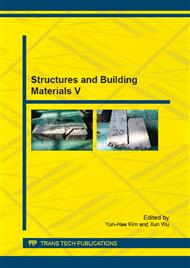[1]
A. Braconi, A. Osta, L. Nardini, and W. Salvatore, WP 3, 4, 5 and 6: Cost, performance and constructive analysis of steel solutions for retrofitting vertical elements, floors, roofs and foundations; Definition of the reinforced concrete benchmark building for the execution of comparative performance analysis between steel intervention techniques, PRECASTEEL internal report (Draft), May (2008).
Google Scholar
[2]
L. A. Fülöp, Application of PBD provisions for the r. c. benchmark structure, VTT Technical Research Centre of Finland, Espoo, Research Report VTT-R-00988-11, (2011).
DOI: 10.3940/rina.efs.2012.10
Google Scholar
[3]
L. A. Fülöp, LGS steel shear wall system to retrofit or upgrade r. c. frame structures, VTT Technical Research Centre of Finland, Espoo, Research Report VTT-R-04770-09, Jan. (2010).
DOI: 10.18057/ijasc.2007.3.3.1
Google Scholar
[4]
M. Mielonen and L. A. Fülöp, Details of retrofit solution using LGS shear walls and column bracketing, VTT Technical Research Centre of Finland, Espoo, Research Report VTT-R-00987-11, (2011).
DOI: 10.18057/ijasc.2007.3.3.1
Google Scholar
[5]
SEISMOSTRUCT Help System.
Google Scholar
[6]
Eurocode 1: Actions on structures - Part 1-1: General actions - Densities, self-weight, imposed loads for buildings, vol. EN 1991–1–1: 2002.
DOI: 10.3403/30396138
Google Scholar
[7]
EN1990, Eurocode - Basis of structural design. Busseles: European Committee for Standardization, (2002).
Google Scholar
[8]
Eurocode 8: Design of structures for earthquake resistance – Part 1: General rules, seismic actions and rules for buildings, vol. EN 1998–1: 2004.
DOI: 10.1002/9783433609194.ch2
Google Scholar
[9]
A. K. Chopra and R. K. Goel, Capacity-demand-diagram Method for Estimating Seismic Deformation of Inelastic Structures: SDF Systems, Pacific Earthquake Engineering Research Centre, Berkeley, (1999).
Google Scholar
[10]
L. A. Fülöp and I. Hakola, Design of light-gauge steel shear walls sheathed with thin steel plates, in Proceedings of the International Conference in Metal Structures - Steel - A New and Traditional Material for Building, Brasov, 2006, p.127–135.
DOI: 10.18057/ijasc.2007.3.3.1
Google Scholar
[11]
L. A. Fülöp and I. Hakola, Design method for light-gauge steel shear walls sheathed with flat steel plates, Adv. Steel Constr. Int. J., vol. 3, no. 3, p.628–651, (2007).
DOI: 10.18057/ijasc.2007.3.3.1
Google Scholar
[12]
P. A. Timler and G. L. Kulak, Experimental Study of Steel Plate Shear Walls, The University of Alberta, Research Report 114, Nov. (1983).
Google Scholar
[13]
F. M. Mazzolani, Innovative metal systems for seismic upgrading of RC structures, J. Constr. Steel Res., vol. 64, no. 7–8, p.882–895, Jul. (2008).
DOI: 10.1016/j.jcsr.2007.12.017
Google Scholar
[14]
D. Schmitt, Experimentelle und numerische Untersuchungen von Stahlschubwänden zur Verstärkung von bestehenden Stahlbetongebäuden unter Erdbebenbelastung, Diploma Thesis, Institute of Steel Construction RWTH Aachen University, (2010).
Google Scholar
[15]
A. Braconi, A. Tremea, G. Lomiento, N. Bonessio, F. Braga, B. Hoffmeister, M. Gündel, S. A. Karmanos, G. Varelis, R. Obiala, P. Tsintzos, D. Vasilikis, J. B. Lobo, P. Bartlam, S. C. Estanislau, L. Nardini, F. Morelli, W. Salvatore, D. Dubina, A. Dogariu, S. Bordea, G. Bortone, N. Signorini, G. Fianchisti, L. Fulop, J. Leven, European Commission, and Directorate-General for Research and Innovation, Steel solutions for seismic retrofit and upgrade of existing constructions (Steelretro). Luxembourg: Publications Office of the European Union, (2013).
Google Scholar
[16]
R. Purba and M. Bruneau, Finite-Element Investigation and Design Recommendations for Perforated Steel Plate Shear Walls, J. Struct. Eng., vol. 135, no. 11, p.1367–1376, (2009).
DOI: 10.1061/(asce)st.1943-541x.0000061
Google Scholar


